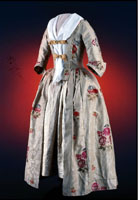Women's Clothing

A detailed and lengthy observation by a visitor to Virginia illustrates the importance of women's clothing in the eighteenth-century British world. Philip Vickers Fithian, a young tutor from New Jersey, recorded in his diary in 1774:
"Miss Betsy Lee...but lately entered her twenty sixth year...is a well set maid, of proper height, neither high nor low...she sits very erect; places her feet with great propriety, her Hands She lays carelessly in her lap, & never moves them but when she has occasion to adjust some article of her dress, or to perform some exercise of the Fan-She has a full face, sanguine Complection, her Nose is rather protuberant than otherwise...her carriage neat & graceful, & her presence soft & beautiful. Her hair is a dark Brown, which was crap'd up very high, & in it she had a Ribbon interwoven with an artificial Flower-at each of her ears dangled a brilliant Jewel; She has pinched up rather too near in a long pair of new fashioned Stays...so high that we can have scarce any view at all of the Ladies Snowy Bosoms...[the stays] are extended downwards so low that...Walking, must, I think, cause a disagreeable Friction of some part of the body against the lower Edge of the Stays…. I imputed the Flush which was visible in her Face to her being swathed up Body & Soul & limbs together-She wore a light Chintz Gown, very fine, with a blue stamp; elegantly made, & which set well upon her-She wore a blue silk Quilt. In one word her Dress was rich & fashionable. Her Behaviour such as I should expect to find in a Lady whose education had been conducted with some care & skill; and her person, abstracted from the embelishments of Dress & good Breeding, not much handsomer than the generality of Women." (Journal and Letters of Philip Vickers Fithian, 1773-1774)
In Fithian's admiring eyes, Elizabeth Lee's apparel, hairstyle, accessories, physical attributes, and body language mark her as a member of the colonial gentry. The status of other women was also announced by what they wore. A short gown and practical cap indicate the status of a housemaid just as plainly as would a broom in her hand.
Some women opposed following fashion due to religious or political beliefs. Quaker women in Philadelphia, for example, dressed in black with very restrained decoration and accessories for an overall "plain" appearance, yet the fabrics themselves might be sumptuous and quite expensive. In 1769 Virginia women forsook fancy gowns when their politics were at stake; they proudly donned homespun for a ball at the Capitol in Williamsburg. A very pious Virginia woman found that if she did not dress up to her role in society, her audience did not pay attention to her religious teachings, yet when she "dressed in rich though not gaudy apparel...her subject [was] but little more regarded."






